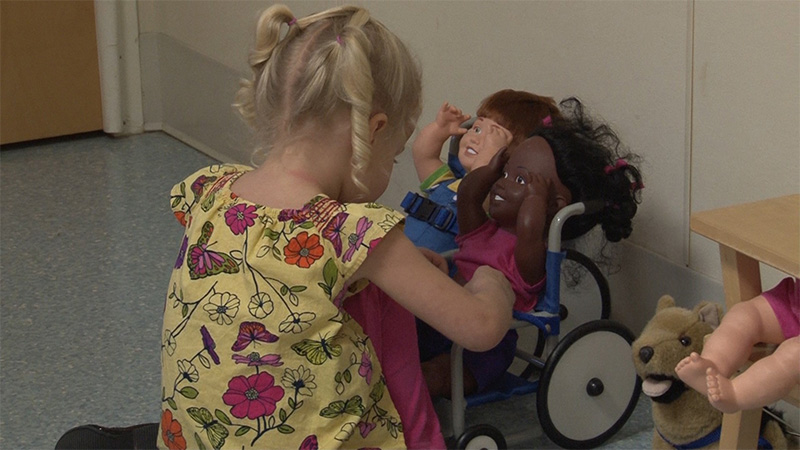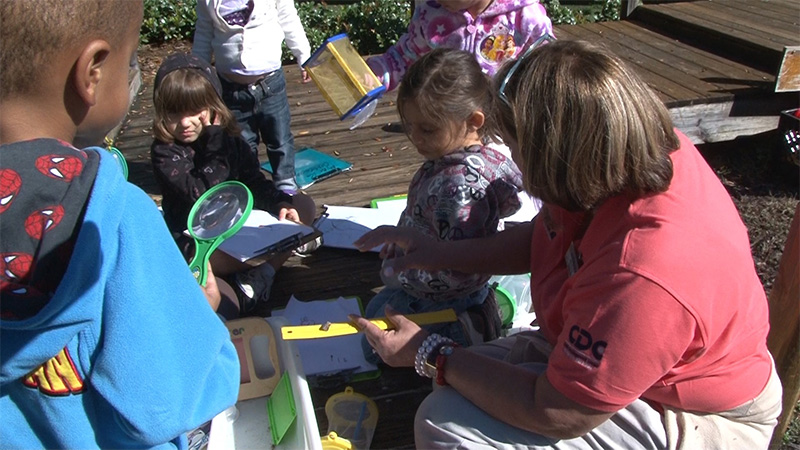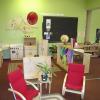- Teach staff members how to select developmentally appropriate materials and help managers make purchasing decisions.
- Model decision-making about the appropriateness of materials.
- Observe staff members as they use learning materials and provide feedback.
Learn
Teach
Staff members are sometimes overwhelmed by the task of selecting and organizing learning materials. You might see a range of materials in classrooms and school-age programs. Consider these examples:
- Mindy is a relatively new staff member in a school-age program. She follows directions when someone tells her to set up an activity or manage the materials in an area. She does not seem comfortable writing activity plans or selecting materials for children herself. When she is responsible for designing activities, children don't seem interested.
- Ramona is a veteran teacher in a preschool classroom. She has held onto materials she likes over the years. She has boxes of materials she rotates in and out. Some of the materials are no longer in good condition. Some of the materials are not considered developmentally appropriate.
- Wallace's toddler room looks like a page from an educational catalog. He follows every guideline and completes every checklist. He can talk to you about why certain materials are good for children. He blends commercially available materials with items the children create, families bring in, and he finds.
How do you help staff decide what toys and materials are worth including in their programs? How do you help your manager make purchasing decisions? Fortunately, you have the knowledge right at your fingertips. Your knowledge of child development should guide your choices and suggestions.
The materials in each classroom or program should be intentionally chosen with the following factors in mind:
- Cultural relevance
- Developmental appropriateness
- Connection to children’s interests
- Variety
- Link to learning goals
Cultural Relevance
Cultural relevance means that the toys and materials you provide reflect the backgrounds, knowledge, and experiences of the diverse children and youth in your program. By choosing materials that validate and empower children of all racial, ethnic, and social backgrounds, staff members build a bridge between children’s home and school lives that will support a strong foundation for learning.
Children can experience diversity in your program by seeing positive images of people from a variety of backgrounds. Staff members should provide items that represent cultures from around the world: cookbooks with pictures of foods, fliers from ethnic grocery stores, fabrics, cooking utensils, traditional clothing. Encourage staff members to ask families to bring family photos and to lend the program items from their homes. Stock the library or reading area with books that give positive messages about age, gender, race, culture, family type, special needs, and linguistic diversity.

Developmental Appropriateness
As children age, their needs change. The materials in your program should help children meet the important learning goals relevant to each developmental stage. Because children develop at different rates, choosing developmentally appropriate materials means providing a range of toys that can accommodate differences between individual children’s skills, interests, and characteristics.
A program stocked with developmentally-appropriate materials fits the child—the child should not have to adjust to fit the program. See the Developmentally Appropriate Materials Guide at the end of the Learn section for details about what children need at different stages in their development. Use the guide to facilitate decision-making by program staff and leadership.
Connection to Children’s Interests
Children learn best when their interests are incorporated. When possible, staff members should provide materials that capture children’s interests and extend their learning.
By considering children’s interests when choosing classroom materials, staff members can make connections that extend children’s learning to new areas. For example, if a few children become very interested in construction during the summer, the teacher could turn a part of the learning area into a construction zone by providing hard hats, shovels, measurement tools, gravel, or toy construction equipment. The creation of this construction zone might spark children’s interest in learning about bridges, which could lead to discussion about rivers or to types of transportation that move through water.

Variety
Not all toys are created equally; some toys spark imagination and others hinder imagination. You might have noticed that young children are often more interested in the box than the toy that came inside it. Why is this so? Because for a child, the box can become anything. It becomes a drum when you hit it. It becomes a house when you put a doll inside it. It becomes a hat when you put it on your head. The possibilities are endless.
Children learn and explore more when toys and materials have multiple uses. Unlike empty boxes, some toys, such as action figures or dolls with pre-set accessories or movements, can only be used in a limited number of ways.
Link to Learning Goals
Perhaps the most important consideration in terms of the materials in your program is the ways materials support learning goals. Provide toys that promote math skills like sorting and patterning, literacy skills like letter matching and rhyming, social skills like turn-taking and problem solving, scientific knowledge, and knowledge of the social world around children. The general rule is that children should want to play with these materials.
Using the Internet and Technology as Learning Tools
You will need to thoughtfully guide how school-age program staff use the internet and technology. Applications or “apps,” computer games, and the internet are learning materials, just like toys and books, and your role is to collaborate with staff to ensure that their use in your program supports learning objectives and healthy child and youth development. All children who use technology in your program will need support in learning digital citizenship. This is essential for their safety, and you can review Lesson Three of the Safe Environments course for guidance on supervision and safety of internet and technology use. The Office of Educational Technology, U.S. Department of Education defines digital citizenship as, “a set of norms and practices regarding appropriate and responsible technology use… and requires a whole-community approach to thinking critically, behaving safely, and participating responsibly online” (2015). Staff should occasionally do refreshers with children on your program’s specific digital citizenship rules and with individual children who need more help in this area, as needed.
As you coach staff in using technology in your program, consider the Three C’s and accompanying questions developed by Lisa Guernsey:
- Content: How does this help children learn, engage, express, imagine, or explore?
- Context: What kinds of social interactions are happening before, during, and after the use of technology? Does it complement, and not interrupt, children’s learning experiences and natural play patterns?
- The individual Child: What does this child need right now to enhance their growth and development? Is this technology an appropriate match with this child’s needs, abilities, interests, and development stage?
The Office of Educational Technology, U.S. Department of Education encourages caregivers and educators to understand the difference between passive and active technology use. During passive technology use, a child consumes the content through watching a video or program without follow-up or an opportunity to connect what they viewed to something in their life. Active technology use involves creation, reflection, and storytelling. For example, a child who has a special interest in cheetahs creates a PowerPoint Presentation using pictures, facts, and other resources. This child may, with the help of an adult or peer model, research facts about cheetahs from reputable online websites or books and insert found pictures to support information about specific cheetah traits. This example of active technology use supports the child’s knowledge of the life sciences, ability to determine fact from fiction, collaboration with peers, and word processing skills. Think about how technology is used in your program. What ways can you support staff so technology use is active, aligns with learning goals and the curriculum, and connects to children’s lives and interests?
Model
As you work with staff members and managers, you will need to model appropriate decision-making related to materials. When staff or managers have questions about materials, ask four important questions (Dodge, Colker, & Heroman, 2002):
- Do these materials reflect and respect the racial, ethnic, cultural, linguistic, and family diversity of the program and of the broader community?
- Do these materials reflect the children's current interests and help spark new interests?
- Do these materials allow children to play in a variety of ways?
- Do these materials help us reach important learning goals for children?
When you help staff members create activity plans and decide what materials to offer at different times, you can expand upon those four questions to make sure materials are meeting children's developmental needs. Model reflection and problem-solving skills by asking staff members questions like:
- Are children still interested in these materials? Do they use them often?
- Does anyone seem bored or disinterested in any materials?
- Does anyone seem to get frustrated easily by any materials?
- What are the children most interested in right now? What topic or idea seems to spark their curiosity?
- What materials do you think would take your plans to the next level?
These questions should help staff members recognize when different materials are needed. After discussing these questions with staff members, help brainstorm the next steps. If, for example, a preschool teacher realizes that children are not engaged in the materials she provides about changing seasons but they are showing interest in construction and buildings, suggest using blocks, construction tools, and hard hats and providing books on construction.
Observe
Let's begin by looking at a case example. Watch how this teacher involves preschool children in making decisions about materials.
Case Example 1: Appropriate Materials
Case Example Step 1: Make a Plan
This teacher seems to know her children well and follow their interests. She makes sure children’s voices are heard in the classroom. A trainer or coach can help a teacher like this make a plan for expanding learning opportunities or reflecting more deeply on children’s learning. The conversation in the video might have been one step in the action plan. Here is a sample plan developed by this teacher and her trainer or coach:
Goal: Create a science lab in the dramatic play center so children choose that center, interact with materials, and engage in pretend play with one another.
Steps to reach the goal:
- Ask the children to brainstorm materials needed to create a science lab. Person responsible and timeline: Caroline (teacher) will lead a group discussion on Tuesday.
- Create a science lab inventory sheet with the children and brainstorm whether we can purchase, borrow, or create all the materials. Person responsible and timeline: Mandy (co-teacher) will type up inventory list based on step 1. Then Caroline and Mandy will discuss it with children in small groups beginning next Tuesday.
- Share list with Ragan (trainer or coach) and discuss what we already have and what we can buy or borrow. Person responsible and timeline: All will discuss next Wednesday.
- Request books from the library about science labs and scientists. Brainstorm with children about what the lab should look like. Record their ideas on sticky notes and post them on chart paper. Person responsible and timeline: Mandy and Caroline during center time next week.
- Work with children to build the lab. Person responsible and timeline: All week of 3/12.
- Observe the science lab and note who visits it, how long they stay, what materials are used. Gather anecdotal records about children's ideas and experiments in the lab and add to portfolios. Take photos. Person responsible and timeline: All, ongoing.
Case Example Step 2: Provide Feedback
It is important to help staff members feel recognized for their efforts and encouraged in their work. Even for your most experienced or skilled staff members, it is crucial to provide feedback about what you see in classrooms or programs. This preschool teacher’s trainer or coach might provide positive feedback by saying:
- "You paid such close attention to the children's interest in science."
- "Your class is working so hard on developing the science lab. That's great to see the whole team working together like that."
To help extend the teacher’s reflection, the trainer or coach might ask questions like:
- "How did you come up with the idea to start a science lab in the classroom?"
- "How did you prepare for the conversation with the children about materials?"
- "Did the children respond the way you expected them to?"
- "Some of the children clearly got it right away, but others gave answers that weren't as clear. What are your ideas for connecting with those children?"
Case Example Step 3: Provide Resources
This teacher’s trainer or coach can help her achieve the goals she has for the classroom. After the children have brainstormed the materials they need, the trainer or coach can help the teacher find, purchase, or borrow the materials. The trainer or coach may also be able to help the teacher find community resources to support learning. Perhaps a local university, hospital, or business would loan or donate lab equipment. The trainer or coach can also help the teacher plan local field trips to support learning. It can be inspiring for children to see scientists at work in local universities or research laboratories.
Additional Examples of Materials that Promote Learning
Now let’s watch a few more examples of staff members providing a range of learning materials. First, you will see a video about the range of materials that can support learning and development for infants and toddlers. Then you will watch how different programs use materials to help send the message, “you belong here.” Finally, you will see an example of the way different materials, in this case art material, can influence learning.
A Range of Learning Materials: Infants and Toddlers
Use the menu at the left or the pager below to cycle through scenarios
See | You Saw:
|
|---|---|
Say | What you might say:
|
Do | What you might do:
|
See | You Saw:
|
|---|---|
Say | What you might say:
|
Do | What you might do:
|
See | You Saw:
|
|---|---|
Say | What you might say:
|
Do | What you might do:
|
A Range of Materials that Help Children See Themselves
Use the menu at the left or the pager below to cycle through scenarios
See | You Saw:
|
|---|---|
Say | What you might say:
|
Do | What you might do:
|
A Range of Materials across a Content Area: Art
Use the menu at the left or the pager below to cycle through scenarios
See | You Saw:
|
|---|---|
Say | What you might say:
|
Do | What you might do:
|
See | You Saw:
|
|---|---|
Say | What you might say:
|
Do | What you might do:
|
See | You Saw:
|
|---|---|
Say | What you might say:
|
Do | What you might do:
|
Explore
Staff members enter your program with a range of knowledge and skill about working with children. They may struggle to identify and use appropriate materials. Read the scenarios in the Talking to Staff About Materials activity, and decide how you would respond to each staff member. Compare your answers to the suggested responses.
Apply
Use these resources to help staff reflect and make decisions about developmentally appropriate materials. Specifically, use the following resources to achieve these goals:
- Questions to Guide Reflection: Ensuring Developmentally Appropriate Materials - help staff think broadly about whether materials are inclusive regarding race, ethnicity, culture, language, family diversity, a child’s own interests, the ability for the material to engage children and inspire a variety of play, and a material’s relationship to your curriculum.
- Child’s Play: Toys and Games for Cooperation – suggests toys that inspire cooperation, imagination, literacy and language, math and problem-solving, science and exploration, and social studies.
- Developmentally Appropriate Materials Best Practices Checklist – eight-point checklist helps you determine whether classroom materials are developmentally appropriate.
- Checklist for Identifying Exemplary Uses of Technology and Interactive Media for Early Learning - twelve-point checklist contains specific guidelines to help you and staff ensure the use of technology and interactive media is developmentally appropriate.
Glossary
Demonstrate
Bronson, M. B. (1995). The Right Stuff for Children Birth to 8: Selecting play materials to support development. Washington, DC: National Association for the Education of Young Children.
Epstein, A. (2007). The Intentional Teacher: Choosing the best strategies for young children’s learning. Washington, DC: National Association for the Education of Young Children.
Goodson, B. D., & Bronson, M. B. (1986). Which Toy for Which Child: A consumer's guide for selecting suitable toys. Washington, DC: U.S. Consumer Product Safety Commission.
Guernsey, L. (2012) Screen Time: How electronic media—from baby videos to educational software—affects your young child. New York, NY: Basic Books.
Jacobs, G., & Crowley, K. (2007). Play, Projects, and Preschool Standards: Nurturing children’s sense of wonder and joy in learning. Thousand Oaks, CA: Corwin Press.
U.S. Department of Education, Office of Educational Technology. (2015.).Ed Tech Developer’s Guide, A primer for software developers, startups, and entrepreneurs. Retrieved from https://tech.ed.gov/files/2015/04/Developer-Toolkit.pdf
U.S. Department of Education, Office of Educational Technology. (n.d.). Guiding principles for the use of technology with early learners. Retrieved from https://tech.ed.gov/earlylearning/principles/


